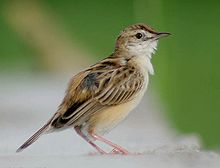- Zitting Cisticola
-
Zitting Cisticola 
C. j. cursitans (Kolkata, India) Conservation status Scientific classification Kingdom: Animalia Phylum: Chordata Class: Aves Order: Passeriformes Family: Cisticolidae Genus: Cisticola Species: C. juncidis Binomial name Cisticola juncidis
(Rafinesque, 1810)The Zitting Cisticola or Streaked Fantail Warbler (Cisticola juncidis), is widely distributed Old World warbler whose breeding range includes southern Europe, Africa outside the deserts and rainforest, and southern Asia down to northern Australia. A small bird found mainly in grasslands, it is best identified by its rufous rump, lacks any gold on the collar and the brownish tail is tipped with white. During the breeding season, males have a zizagging flight display accompanied by regular "zitting" calls that has been likened to repeated snips of a scissor. They build their pouch nest suspended within a clump of grass.
Contents
Description
The Zitting Cisticola is brown above, heavily streaked with black markings. The underparts are whitish, and the tail is broad, white-tipped and flicked frequently, giving rise to the alternative name for the species. The adult males have less crown streaking and more back marking than the females, but there are no great difference between the sexes or the eighteen geographical races. The absence of a nuchal collar separate it from Cisticola exilis. In the non-breeding season, they tend to skulk within the grass and can be hard to spot.[2][3]
Taxonomy and systematics
Across their wide distribution range, several variations in populations have been noted and as many as 18 subspecies are recognized. They differ slightly in calls, plumage and size and some have been considered full species in some taxonomic treatments. The nominate form is found in southern France, Greece, Turkey, Sicily, Corsica and Egypt while western Portugal and Spain have cisticola. The population in Israel, Syria, Iraq and Iran is neuroticus while the northern and eastern African population is uropygialis and perennius (further south). Gabon, Angola, southern Africa are home to terrestris. The population in the Western Ghats of India, salimalii does not show seasonal tail length variation as in cursitans of the plains of India and dry-zone of Sri Lanak which has a longer tail in the non-breeding season. Population malaya is found in southern Southeast Asia, tinnabulans further north in southern China while brunniceps is found in Korea and Japan. Other populations include nigrostriatus (Philippines), constans (Sulawesi), fuscicapilla (east Java), leanyeri (northern Australia), normani (northwest Queensland) and laveryi (northeast Australia).[4]
This genus is sometimes split off with various other southern warbler genera and given family status as the Cisticolidae. This species was previously known as Fan-tailed Warbler , but the current name gives consistency with the many tropical cisticola species, and avoid confusion with an American species also named Fan-tailed Warbler.
Habitat and distribution
This species is found mainly in grassland habitats, often near water. Most populations are resident, but some East Asian populations migrate south to warmer areas in winter. In the Himalayas, they ascent to about 1,900 metres (6,200 ft) during summer but are below 1,300 metres (4,300 ft) in the winter. This species is a rare vagrant to northern Europe, mostly as a spring overshoot. Its European range is generally expanding, although northern populations are especially susceptible to hard winters.[5]
Behaviour and ecology
Zitting Cisticolas are very small insectivorous birds, sometimes found in small groups. The breeding season is associated with the rains. Two broods a year occur in many regions.[6] Males are polygynous but some are monogamous[7] the male builds the initial nest structure deep in the grasses, and invites females using a special display. Females that accept the male complete the nest. The nest is made by binding living leaves into the soft fabric of felted plant-down, cobwebs, and grass. The Zitting Cisticola's nest is a cup shape with a canopy of tied-together leaves or grasses overhead for camouflage; 3-6 eggs are laid. The female incubates the egg. The eggs hatch after about 10 days. More than one brood may be raised.[2] Females change their mates frequently and rarely stay within the same territory, while males are less mobile.[8] Females can sometimes breed in their first year.[9][10]
References
- ^ BirdLife International (2009). "Cisticola juncidis". IUCN Red List of Threatened Species. Version 2009.2. International Union for Conservation of Nature. http://www.iucnredlist.org/apps/redlist/details/148154.
- ^ a b Ali, S; S D Ripley (1997). Handbook of the Birds of India and Pakistan. Volume 8 (2 ed.). New Delhi: Oxford University Press. pp. 31–35.
- ^ Rasmussen, Pamela C; Anderton, J C (2005). Birds of South Asia. The Ripley Guide. Volume 2. Smithsonian Institution and Lynx Edicions. p. 468.
- ^ Mayr, E; Traylor, M A, Jr; Watson, G A (1986). Check-List of birds of the world. Volume 11. Museum of Comparative Zoology, Cambridge Massachusetts. pp. 114–117. http://www.archive.org/stream/checklistofbirds111986pete#page/113/mode/1up.
- ^ Nemeth, A; Vadasz, C S (2008). "First record of the Zitting Cisticola (Cisticola juncidis Rafinesque, 1810) in Hungary". Opusc. Zool. Budapest 37: 89–90. http://opuscula.elte.hu/PDF/Tomus37/8_Cisticola_C.pdf.
- ^ Avery, M L (1982). "Nesting biology, seasonality, and mating system of Malaysian fantail warblers". Condor 84: 106–109. http://elibrary.unm.edu/sora/Condor/files/issues/v084n01/p0106-p0109.pdf.
- ^ Ueda, Keisuke (1984). "Successive nest building and polygyny of Fan-tailed Warblers Cisticola juncidis". Ibis 126 (2): 221–229. doi:10.1111/j.1474-919X.1984.tb08001.x.
- ^ Ueda, K (1986). "A Polygamous Social System of the Fan-tailed Warbler Cisticola juncidis". Ethology 73 (1): 43–55. doi:10.1111/j.1439-0310.1986.tb00998.x.
- ^ Ueda, K (2008). "Juvenile female breeding of the Fan-tailed Warbler Cisticola juncidis: occurrence of two generations in the year". Ibis 127 (1): 111–116. doi:10.1111/j.1474-919X.1985.tb05041.x.
- ^ Yamagishi, S; Ueda, K (1986). "Simultaneous territory mapping of male fan-tailed warblers (Cisticola juncidis)". Journal of Field Ornithology 57 (3): 193–199. http://elibrary.unm.edu/sora/JFO/v057n03/p0193-p0199.pdf.
External links
Categories:- IUCN Red List least concern species
- Cisticola
- Birds of Western Australia
- Birds of India
- Birds of Nepal
- Birds of Pakistan
- Birds of Africa
- Birds of Europe
- Birds of Turkey
- Birds of Japan
- Birds of Asia
- Animals described in 1810
Wikimedia Foundation. 2010.


